The content of the article
It's hard to believe, but in some countries, mango is the main export product. Residents are engaged in its cultivation, collection, sorting and packaging for export to other parts of the world. A separate time is allocated in the news channels to notify about the quantity of the collected product, its quality and the approximate cost of the sale. Mango appeared on the shelves of supermarkets relatively recently, immediately receiving a huge army of admirers of its delicate exquisite taste.
Appearance and properties
Mango trees are considered a national wealth in India, China, Burma, Thailand. Its cultivation is economically beneficial for these countries. He is called the "king of fruits", used for food, used for medicinal purposes. There are several varieties that differ in shape, size, color, taste. Experts at a glance or a piece determine the region of cultivation.
The fruit has an elongated egg-shaped structure, the weight, depending on the variety, ranges from 250-400 g. Occasionally there are record holders of 1.5 kg. They do not have important trade value and are rather interesting facts. Mango has the richest taste from India and Thailand, medium-sized fruits are chosen for export, and in season, you can find both tiny and giant fruits on the markets of these countries.
The real taste can only be felt in ripe mangoes ripped from a tree. An amazing combination of notes of pineapple and peach is seasoned with a delicate aroma. In the export version, the taste is significantly changed, since the fruits are still picked green, and then stored for a long time. Arrived in this way, they will never gain the natural richness of taste.
In folk medicine, fruits, leaves, bark and young branches of a plant are used. Mangoes are recommended for poor health, a tendency to be overweight, problems with blood vessels, and failures in thought processes.
The benefits of overseas fruit
Regular inclusion of mangoes in the diet as a dessert or a fresh independent dish:
- normalizes blood sugar;
- lowers cholesterol;
- fiber improves the functioning of the small and large intestines;
- eliminates constipation and diarrhea;
- cleanses, promotes the removal of toxins;
- compensates for the deficiency of vitamins and minerals;
- stabilizes blood pressure;
- supports and strengthens the heart muscle;
- improves memory, sharpens attention and increases the ability to concentrate;
- uplifting;
- relieves stress;
- maintains visual acuity and slows the development of age-related macular degradation;
- protects cells from degeneration into malignant;
- prevents the occurrence of anemia;
- struggling with premature aging.
Mango is a powerful aphrodisiac and is recommended for restoring sexual function. A dessert based on it perfectly complements a romantic dinner and awakens the severity of desire.
Possible harm
After praising the miraculous properties, it is hard to believe that mangoes can be forbidden to anyone. Nevertheless, there are such indications. It is not offered to infants, with an allergic reaction and individual intolerance. In people with hypersensitivity to urushiol, the fetus causes dermatitis. Due to the large amount of potassium in the juicy pulp, people with kidney failure will have to limit the amount of goodies. Unripe fruits cause a burning sensation, indigestion and indigestion.
Keep in mind: any fruit, including mango, cannot eat too much.
According to the recommendations of nutritionists, 1-2 fruits per day are enough to meet the needs of the body. It is also worth revising the number of sweet pieces in pancreatitis. Preparing for a fun party, housewives need to remember that mango slows the removal of ethyl alcohol from the body.
Buying Choice
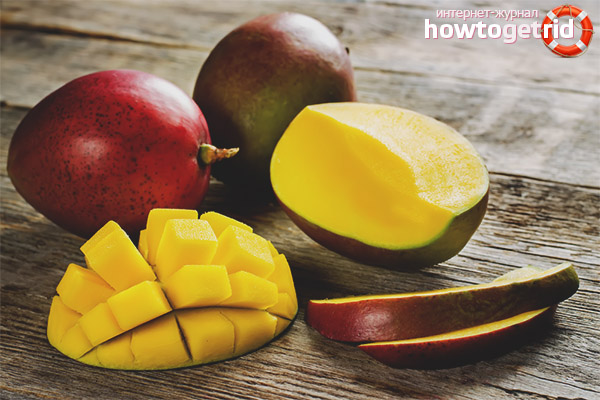
The taste of the fruit directly depends on its quality. If you consider that he has come a long way from a tree branch in Thailand or India to the domestic counter, then the choice must be approached very responsibly. Several types are on sale, the most popular variety has a yellow-red color, weighs approximately 350-400 gr. The most delicious fruits are recognized from India and Thailand.
Ripe fruit:
- dry and velvety to the touch;
- heavy enough;
- dense;
- without dark and wet spots;
- with a light finger touch, a hollow remains, which quickly disappears;
- from the fruit comes a pleasant peach-like floral aroma.
Too hard fruits without aroma have not yet ripened, an acidic shade of smell indicates that the process of decay has begun.
How to peel and serve mangoes on the table
In general, the fruit seduces with aroma and just requires a bite of sweet pulp. But this can be done to an individual who bought fruit for his beloved. Most often you have to cut it into pieces for the whole family.
The fruit has a thick peel, in which there are practically no useful substances, but there is urushiol, which causes a skin rash with a tendency to allergic reactions. It must be carefully cut with thin chips. The bone is also completely inedible. You can take advantage of the experience of revealing apricot or plum halves. At the same time, the degree of ripeness of the fetus is checked again. If the pulp is porridge-like, then its time has already passed, hard pulp with almost no smell indicates immaturity.
If the treat is for two, then you can eat the pulp with a teaspoon directly from the skin. She will fulfill the role of a plate.
The original method was invented for those who do not want to mess with a knife or are not sure of their skill. The fruit is cut into 4 parts, the seed is removed. Then the quarter is leaned against the edge of any glass or wine glass so that the flesh looks inside the container, and the fragment of the skin remains outside. Pressing lightly, they lead a piece of fruit down, separating the skin. This will preserve most of the juice, once in a glass.
Whatever method was chosen, the main thing is that on the table there will be a fragrant and very tasty tropical guest, but bearing the dignity of the “king of fruits”.
Video: how to peel a mango with a bone

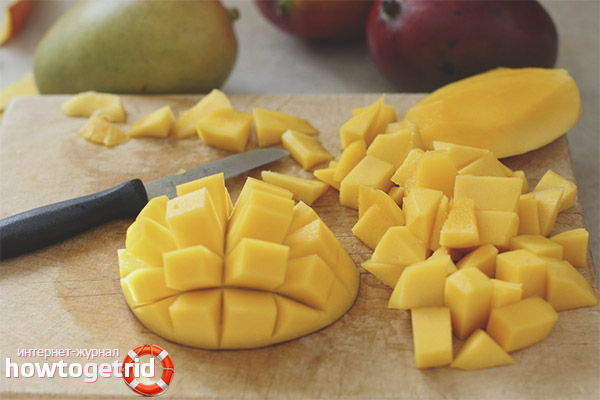

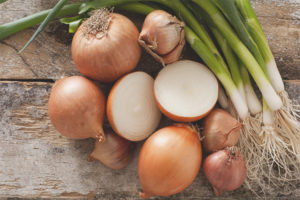


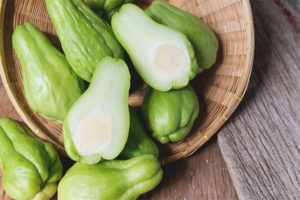

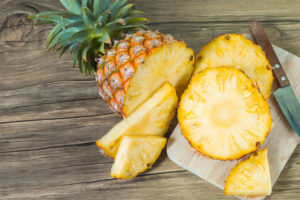

Submit